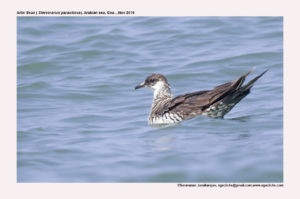
Artic Skua Stercorarius parasiticus
Etymology:
- Stercorarius : Latin name for “ of the dung”. skuas’ pursuit of other seabirds until they disgorge their food, the disgorged food once thought to be excrement, hence a former name Dung-hunter.
- Parasiticus : Latin word for Parasite
Vernacular Names: Mar: Parajivi Samudrachor
Distribution in India: Pelagic bird found about 30 km from coasts.
Description: Size of 41–46 cm; wt. of 330–610 g; wingspan of 110–125 cm. It is polymorphic. The two colour morphs are strikingly different: dark morph, common at South end of breeding range, uniformly sooty brown; heterozygotes, often called intermediates, are almost identical to dark morph, but with paler cheeks and often slightly paler belly. The pale morph, commoner further North and almost 100% of population above 75° N, has cream underparts and hindneck, with straw yellow ear-coverts and side of neck, and may have a pale brown pectoral band. Pale morph is very variable and can be quite dusky: such birds are often called “intermediates”, but are in fact still homozygous for the principal light morph. Adult plumage becomes barred through feather wear and when birds moult in autumn. The pale panels are evident on underwing, but not very distinct on upperwing. The dark morph juveniles have dark brown, brown and grey barred plumage, while pale morph juveniles have brown, golden brown and cream barring. Legs are blue in juveniles, but darken to black by adult plumage, at three years old or more; central tail feather projection increases to adult age.
Habitat: It is marine, and predominantly coastal, in winter often aggregating at coastal sites such as estuaries frequented by large numbers of terns or small gulls.
Food habits: It obtains most or all of food by Kleptoparasitism, especially stealing fish from Arctic Terns. It eats Fish, small mammals like rodents, fledgling passerines, wader chicks, birds’ eggs, insects and berries
Breeding habits: They breed in May or June, later in the north of the range than in the south. They are colonial at seabird sites or widely scattered over tundra. They are territorial. The nest is a scrape unlined and inconspicuous. They lay a clutch of 2 eggs. The incubation period is 26–27 days. The chick leaves nest 1–2 days after hatching. The fledging period is 26–30 days.